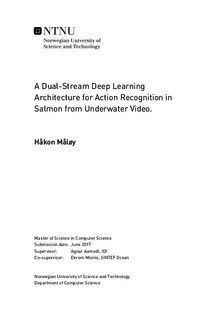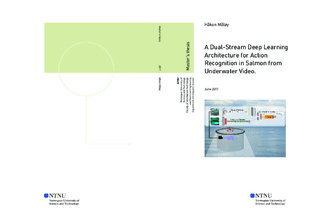| dc.description.abstract | Over half of the costs from breeding salmon in the Norwegian salmon farming
industry comes from feed usage. Today the feeding process is largely a manual
labor, requiring an operator to monitor the amount of feed sinking to the bottom
of a breeding cage. When the amount of feed exceeds a certain threshold, the
feeding process is terminated. Automation of this process and using salmon motion
behavior instead of sinking feed to determine when to terminate feeding, could
greatly reduce costs both in through the labor needed and amount of feed wasted.
Resent developments in Human Action Recognition have shown that Deep
Learning approaches are well suited to perform Action Recognition. We
therefore examine the feasibility of using Deep Learning approaches to automate the
feeding process. We use 76 videos of salmon collected from within a breeding cage
during the month of November 2016. Using these videos for training, validation
and testing, we propose three approaches to automatically classify Feeding and
NonFeeding behavior in salmon. The three approaches are a Spatial Architecture, a
Spatial Recurrent Architecture and a Dual-Stream Architecture.
Our results show that all our proposed architectures are able to separate videos
of Feeding and NonFeeding salmon with high accuracy. We also find that the Dual-
Stream Architecture is the best performing architecture. It combines spatial and
temporal information through the use of a Spatial Stream, a novel Temporal Stream
and a Recurrent Neural Network (RNN). Our Dual-Stream Architecture is able
to accurately classify 80.0% all of our testing videos, presenting state-of-the-art
performance.
To the best of our knowledge, both our Temporal Stream and our Dual-Stream
Architecture are original and novel architectures, as is the application of Deep Learning inference models for the Salmon Activity Recognition domain in optimization
of feeding operation in Norwegian Aquaculture. We hope the results presented in
this thesis will contribute to achieve a higher sustainability in Norwegian salmon
aquaculture, optimize feeding operations, and consequently reduce potential waste.
Future work beyond the results presented in this thesis concerns research on understanding of what our the Deep Learning architecture have learned and visualizing
this learning process. | |

